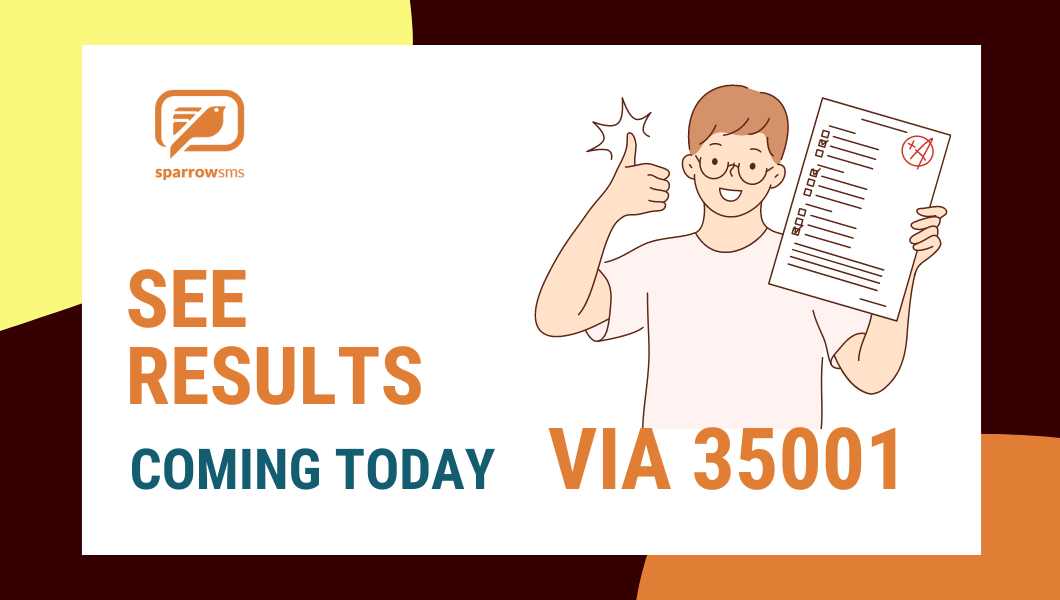The wait is finally over! The SEE (Secondary Education Examination) results for the year 2080-2081 are being released today. We know how important this moment is for students across Nepal, and we’re here to make it as smooth and stress-free as possible. How to Check Your SEE Result? To check your results quickly and easily, just follow these simple steps: Compose a New SMS: Open your messaging app. Enter Your Symbol Number: Type your SEE symbol number in the message. Send to 35001: Send the SMS to the number 35001. Get Your Results: You’ll receive your results within seconds. Why Choose Sparrow SMS? Sparrow SMS is dedicated to providing reliable and efficient services to ensure you get your results without any hassle. Our system is designed to handle high volumes of requests, so you can receive your results promptly. Stay Updated Follow us on social media and visit our website for the latest updates and information. We’re proud to support students and their families on this important day. Good luck to all SEE students! We’re excited to help you get your results quickly and easily. #SEE2080 #SEEResults #SparrowSMS #ExamResults #NepalEducation Stay prepared and stay connected with Sparrow SMS!
The anticipation surrounding the release of SEE results can be both exciting and nerve-wracking. As the moment approaches for students in Nepal to receive their SEE (Secondary Education Examination) results for 2081, many questions naturally arise. To help ease your concerns and provide clarity, we’ve compiled a list of the most frequently asked questions about SEE results. From checking your results to understanding the rechecking process and planning your next steps, this blog covers it all. How to Check Your SEE Results? Where Can I Check My SEE Results? SMS Service: Type SEE <space> your symbol number and send it to 35001 via SMS Official Websites: Visit National Examination Board (NEB) official website or Sparrow SMS. School: Many schools post the results on their notice boards. What Details Do I Need to Check My Results? You will need your symbol number, which is provided on your SEE admit card. What Should I Do if There’s an Error in My SEE Result? Who Should I Contact for Errors in My Results? School Administration: Start by informing your school administration or examination department. National Examination Board (NEB): If the school cannot resolve the issue, contact the NEB directly at Sanothimi, Bhaktapur. What Documents Should I Prepare? Keep copies of your SEE admit card and any other relevant documents handy. These will be necessary to verify and correct any errors. How Does the Rechecking Process Work? Can I Request a Recheck of My SEE Results? Yes, if you believe there has been a mistake in the grading, you can request a recheck. How Do I Apply for a Recheck? Application Form: Obtain and fill out the rechecking application form from your school or the NEB office. Fee Payment: Pay the required rechecking fee. This can typically be done through your school or directly to the NEB. Submission: Submit the form along with the fee receipt within the specified deadline. What If I Don’t Pass the SEE Exam? Is It Possible to Fail the SEE Exam? The OCE has declared that students will not receive an F grade. However, if you score below a 1.6 GPA or less than 35%, your results will be classified as non-graded, meaning you won’t be promoted to grade 11. What Are My Options if I Don’t Pass? Reappear for Exams: You can reappear for the SEE exams to improve your grades. Vocational Courses: Consider enrolling in vocational courses that offer practical skills and training for various careers. Alternative Education Paths: Explore alternative education paths that do not require traditional SEE qualifications. What Should I Do After Receiving My SEE Results? Planning for Higher Secondary Education Stream Selection: Choose between Science, Management, Humanities, or Education based on your interests and career goals. Research Schools: Look into different higher secondary schools and their programs to find the best fit for you. Considering Vocational Training Technical Courses: Enroll in technical courses like engineering, IT, or healthcare. Skill Development: Participate in skill development programs that align with your career aspirations. Tips for Making Informed Decisions Self-Assessment: Evaluate your strengths, interests, and long-term goals. Understanding what you enjoy and excel at can help you choose a suitable path. Research: Gather information about the various streams and courses available. Understand the curriculum, career prospects, and potential challenges. Seek Guidance: Talk to teachers, parents, professionals, and alumni. Their experiences and advice can provide valuable perspectives. Stay Open-Minded: Be open to exploring different fields. Sometimes, the best opportunities come from unexpected places. Plan Ahead: Consider the long-term implications of your choices. Think about where you want to be in 5 or 10 years and how your current decisions can help you get there. Conclusion Receiving your SEE results is a significant milestone, but it’s just one step in your educational journey. Whether you move on to higher secondary education, vocational training, or another path, the key is to make informed and thoughtful decisions. Remember, success is not defined solely by your SEE results but by your determination, resilience, and willingness to pursue your dreams. Stay positive, seek guidance, and keep striving towards your goals.

